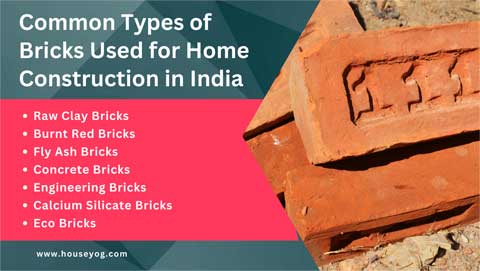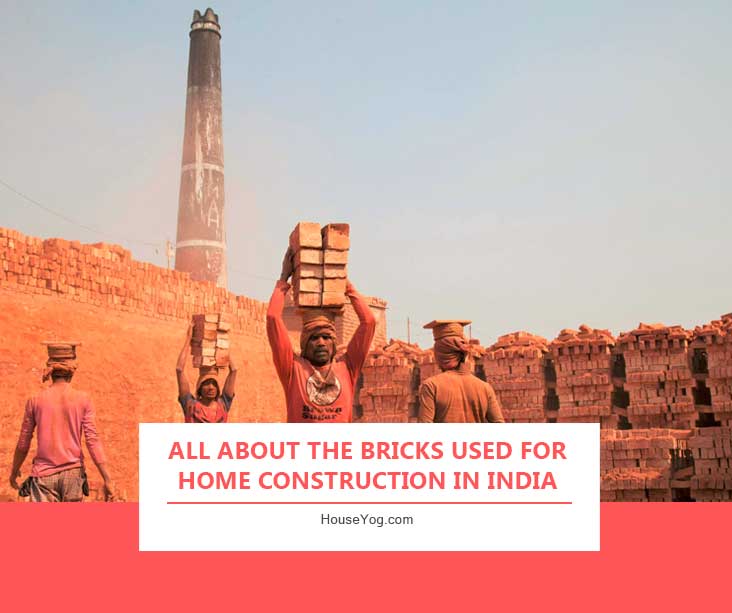Bricks, composed of sand, lime, clay, or cement, have stood the test of time as the favoured materials for constructing robust and aesthetically pleasing buildings. While primarily employed for walls and pavements, bricks extend their utility to various construction domains, including load-bearing walls, pavements, flooring and road construction. Boasting diverse shapes, types, colours, and qualities, bricks cater to multifaceted construction needs.
Renowned for their unyielding strength, durability, and fire resistance, bricks continue to be a cornerstone in construction, maintaining their popularity from ancient times to the present day.
If you are embarking on the journey of constructing a home in India, navigating the myriad types of bricks available can be a daunting task. Fear not, as this guide comprehensively outlines everything you need to know to make informed decisions for your upcoming home construction project.
What are the Different Types of Bricks Available in India?
The landscape of available bricks in India is diverse.
Here’s an exploration of the most common types:


Sun-Dried Bricks
Crafted from clay and straw, sun-dried bricks offer affordability due to low production costs. While not as robust as fired bricks, they find utility in temporary constructions, leveraging their cost-effectiveness.
Burnt Clay Bricks
A stalwart in Indian construction, burnt clay bricks stand out for their strength, durability, and variety in size, shape, and colour. Classified as Grade A, B, C, and D, these bricks find applications in various construction needs.
Fly Ash Bricks
A contemporary alternative, fly ash bricks combine fly ash, cement, and water, providing a newer option for load-bearing constructions such as interior and exterior walls.
Concrete Bricks
Fashioned from cement, sand, and water, concrete bricks exude strength, durability, and resistance to fire and weathering. These types of bricks are Ideal for constructing load-bearing structures and paving blocks.
Engineering Bricks
For those seeking optimal strength and water resistance, engineering bricks, fired at high temperatures, offer density and resilience. Engineering bricks are commonly employed in heavy load-bearing structures.
Calcium Silicate Bricks
Blending sand and lime, calcium silicate bricks emerge as a choice for high-rise buildings, offering strength, durability, and resistance to fire.
Eco Bricks
In harmony with environmental concerns, eco-bricks, crafted from recycled materials like plastic bottles and paper, have gained popularity for non-structural purposes like garden walls and landscaping.
How to Identify the Best Bricks for Construction Projects?
The foundation of robust construction lies in choosing the right type and quality of bricks. Identification involves assessing the size, colour, texture, and sound produced when tapped. In India, a common brick size is 8.5 inches by 4.25 inches by 2.75 inches (215 mm x 102.5 mm x 65 mm), emphasizing the importance of uniformity for load-bearing structures.
Consider colour and texture, opting for smooth surfaces and sharp edges for load-bearing walls and embracing varied textures and patterns for decorative purposes.
The auditory test, tapping the bricks to elicit a clear ringing sound, serves as a reliable indicator of quality.
What are the Common Properties of Bricks?
Understanding the properties of bricks is paramount for selecting the most suitable ones for your construction project. Here’s an in-depth look at these properties:


Hardness: Sturdy and hard bricks signify durability and longevity, which are crucial for sustained construction.
Compressive Strength: A pivotal factor determining a brick’s ability to withstand compression. Conducting compressive strength tests aids in selecting higher-quality bricks.
Absorption: Bricks with low absorption rates resist water-induced cracking, making them preferable for construction purposes.
Thermal Conductivity: This property determines a brick’s ability to conduct heat. Bricks with low thermal conductivity are ideal for insulation, ensuring consistent indoor temperatures.
Efflorescence: White deposits on brick surfaces, a result of soluble salts, can weaken bricks, making them less suitable for load-bearing structures.
Alkali Resistance: Resistance to alkaline materials, such as cement, ensures bricks remain undamaged when exposed to these substances.
Conclusion
In conclusion, this guide serves as an invaluable resource for home builders in India, providing insights into the diverse world of bricks. With this knowledge, you can make informed decisions when choosing bricks that align with your construction needs, ensuring a sturdy and enduring home.






